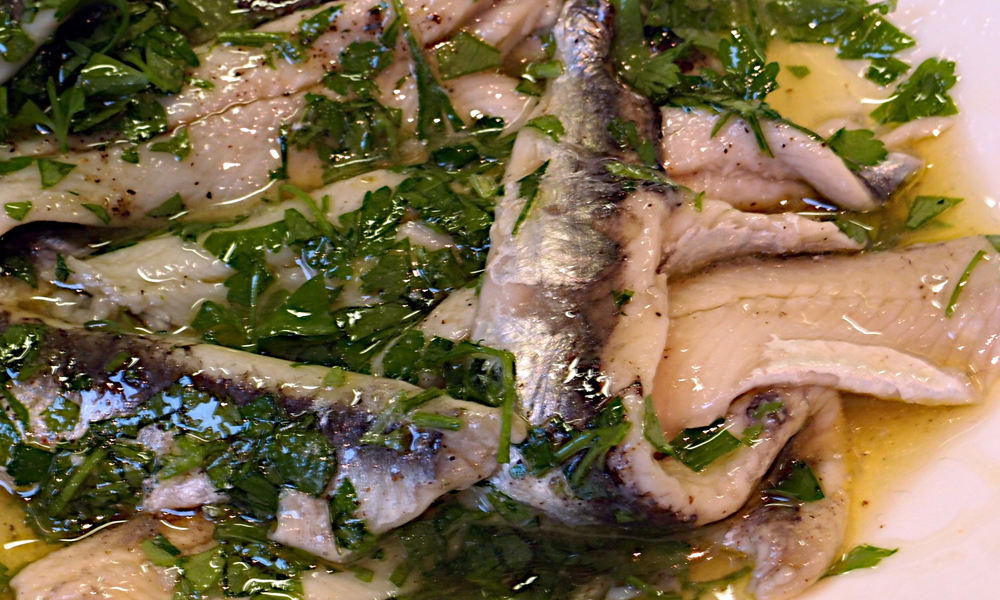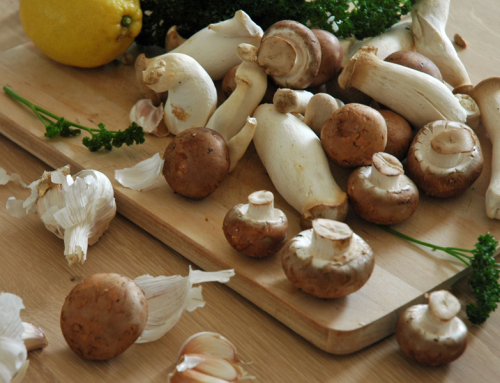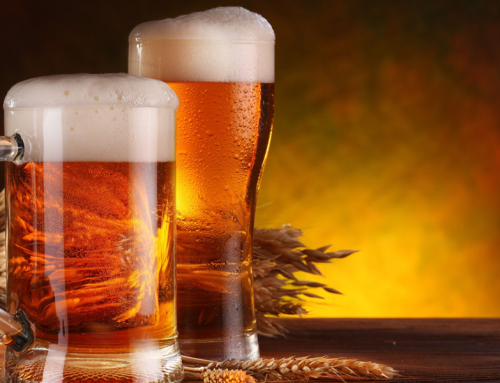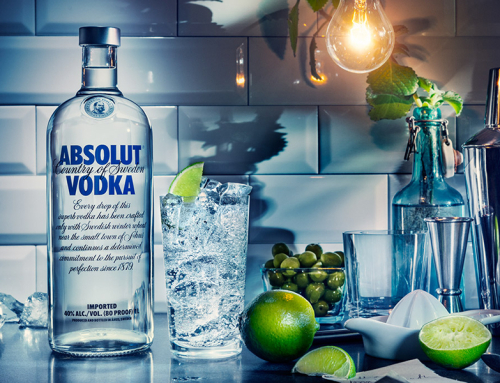Anchovies, Raw
- 100 grams = 131 calories
- 3 oz, 85 grams = 111 calories
- 5 fillets (20 grams). = 26 calories
Anchovy, Canned in Oil, Drained Solids
- 100 grams = 210 calories
- 1 oz, boneless, 28.35 grams = 60 calories
- 1 anchovy, 4 grams = 8 calories
- 1 can (2 oz), 45 grams = 94 calories
- 5 anchovies, 20 grams = 42 calories
Sardines
- 100 g water-packed = 140 calories
- 100 g oil-packed, drained = 210 calories
Pilchards
- 100 g water-packed = 140 calories
- 100 g oil-packed, drained = 210 calories
Herring
- 100 g packed in oil = 489 calories
- 100 g raw Atlantic Herring = 158 calories
- 100 g raw Pacific herring = 195 calories
- 100 g pickled herring = 262 calories
Sprats
- 4 oz. = 113 calories
- 3 oz. = 85 calories
- 2 oz. = 57 calories
- Anchovies contain no carbohydrates.
- Since anchovies have a short lifespan, they are less likely to accumulate dioxins, mercury and other pollutants in the sea than larger, longer-lived fish. In fact, anchovies are listed as the fish with the least amount of mercury that is safe to consume.
- Anchovies are an excellent source of high-quality protein which is essential for growth and maintenance of muscles and organs.
- Like most fish, anchovies are very low in saturated fat.
- Like Salmon and Mackerel, anchovies are very high in Omega-3 fatty acids. These are healthy unsaturated fats that lower inflammation and can reduce the risk of cardiovascular disease by 1/3 in people who eat one or two 3-ounce servings of oily fish each week.
- A 20 gram serving size of 5 fresh European anchovies have 0.3 grams of omega-3 fatty acids which represents 19% of the recommended daily requirement for men and 27 percent for women.
- Anchovies are a rich source of calcium, iron, potassium and selenium. Iron is essential for red blood cell production. Selenium is a trace element that can lower the risk of stroke or atherosclerosis, and may play a role in preventing prostate, stomach, lung and skin cancer. Potassium is crucial to heart function and muscle contraction and is important for normal digestive function as well. Calcium, along with magnesium and phosphorus are essential for bone and tooth health Calcium and magnesium together are important to the cardiovascular system, one promotes muscle contraction, the other relaxes, and between them they regulate heart beat and blood pressure.
- Anchovies are a rich source of vitamins A, E, and niacin. Niacin supports the immune system, helps release energy from food, has been shown to lower cholesterol and triglycerides and may reduce the risk of heart attack. Vitamins B-12 and B-6 are important for removal of a substance from the blood that contributes to heart disease.. Vitamin A is important for healthy vision and healthy immune system, while vitamin E is an antioxidant that helps protect the body against damage caused by free radicals.
- A 20 gram serving size of 5 European anchovies canned In oil contains the following minerals:calcium: 232.00 mg; Magnesium: 69.00 mg; Potassium: 544.00 mg; Zinc: 2.44 mg; Iron: 4.63 mg; Phosphorus: 252.00 mg; Manganese: 0.10 mg; Selenium: 68.10 mg; Copper: 0.34 mg and Sodium: 3,668.00 mg.
- A 20 gram serving size of 5 European anchovies that have been packed In oil contains the following vitamins: Vitamin A: 40.00 mg; Vitamin B1 (Thiamin): 0.08 mg; Vitamin B2 (Riboflavin): 0.36 mg; Vitamin B3 (Niacin): 19.90 mg; Vitamin B5 (Pantothenic Acid): 0.91 mg; Vitamin B6: 0.20 mg; Vitamin B12: 0.88 mg; Vitamin D: 69.00 mg; Vitamin E: 3.33 mg; Vitamin K: 12.10 mg; Folate: 13.00 mg; Choline: 85.00 mg; Retinol: 12.00 mg.
- A 20-gram serving size of 5 European anchovies canned In oil contains the following essential fatty acids: Saturated Fats: 2.20 mg; Monounsaturated Fats: 3.77 mg; Polyunsaturated Fats: 2.56 mg; Cholesterol: 85 mg.
So what exactly are anchovies?
Anchovies are small, greenish-blue, common salt-water fish that are classified as oily fish because they contain high amounts of the heart-healthy polyunsaturated fatty acids. At least 144 species in 17 genera are found in the Atlantic, Indian, and Pacific oceans. They have a large lower jaw that herring and sardines do not have and they are between one quarter of an inch and 16 inches long as adults, depending on the species. The more slender fish are found in the northern schools. However, it is the European anchovy, Engraulis encrasicolus, that is the main commercial anchovy species. Morocco is the largest supplier of canned anchovies.
The consumption of anchovies as a food fish dates back to Roman times when anchovies were used as the base for a fermented fish sauce that had a sufficiently long shelf life. It was important in Roman commerce. Raw anchovies were also used as an aphrodisiac.
In North America, anchovies are used as a pizza topping, as an optional ingredient in a Caesar salad or salad dressing, in pasta dishes, and as a component in Worcestershire sauce.
But around the world they are eaten in a variety of different ways such as fresh, dried, fried, deep fried, grilled, steamed, as a meatball, in baklava and pilaf. They are often used to make fish stock, soup base fermented and used in fish sauces. Anchovies give sauces and dressings a salty flavor rather than fishy one. Anchovy paste is also available, as is anchovy essence.
Anchovies are a high sodium food especially when purchased in pull-tab cans or in jars. They are sometimes wrapped around capers.
So, what makes anchovies taste so fishy-tasting and so salty?
The strong taste of the anchovy is due to the curing process. Fresh anchovies, which are rarely available in the United States, have a much milder flavor.
Raw anchovies are first gutted and then preserved in a salt cure before being packed in oil or in even more salt. Even if the package states that they are packed in water, it is usually a salty brine. This results in a strong flavor and turns the flesh into a deep gray. Spanish anchovies are pickled in vinegar, which gives them a milder flavor, and the vinegar keeps the flesh naturally white.
To give you a comparison of the sodium issue, 20 grams of fresh anchovy fillets have only 21 milligrams of sodium, but 20 grams of processed anchovies may have more than 700 milligrams depending on how they were processed.
Considering that the recommended daily intake of sodium should be no more than 1,500 milligrams, you may want to watch your sodium intake carefully on the days that you choose to eat anchovies.
You can eliminate some of the excessive salt by either rinsing them or by soaking them in cold water for 30 minutes before eating them.
What about the other look-alike fish in the look-alike cans?
Herrings, sprats and pilchards are known as “Clupeiform” fish because they have true bony skeletons, while anchovies have a cartilaginous one. Herring is often pickled in wine or sweet vinegar, or smoked and sold as kippers which are usually packed in either oil or brine or sauce, just like anchovies. Herring is also larger than the typical European anchovy and a delicacy of Scandinavia where it is rumored that there are at least 150 ways to prepare herring.
Sprats belong to the genus Sprattus. The term is also applied to other small sprat-like forage fish. They travel in large schools with other fish and so may be passed off as other fish such as herring, pilchard, or anchovy. They are known for having a smooth flavor and are easy to mistake for baby sardines. European sprats are usually smoked and preserved in oil. In fact, sprats, if smoked, are considered to be one of the foods highest in purine content, which is the most widely occurring nitrogen-containing heterocycle in nature and present in DNA.
Sardines, on the other hand, actually do not exist as a real fish species, but rather that is simply the name given to half-grown pilchards, sprats or herrings.
Because of this cover-up, canned sardines have the heads removed, while anchovies are sold with the heads intact. Sardines are cooked, not salt-preserved, by either steaming or deep frying and then they are dried and packed in either vegetable oil, brine water or a sauce (usually tomato sauce). Sardines have much less sodium, though it is still on the high side, but they would be a better choice than anchovies for those who are watching their sodium intake.
All of these fish look very much alike, but with minor differences. All are sold in cans, used for bait, and also used for feeding the fish farm residents. Nutritionally, they are all very similar with high-quality nutrients, and Omega-3 fatty acids, so eat whichever fish that tastes the best to you, while keeping an eye on the sodium issue.
Warning:
Anchovies have the ability to concentrate domoic acid, a natural bio-toxin that is produced by Pseudo-nitzschia sp., a naturally-occurring microscopic algae more commonly known as a diatom. High levels of this toxin are produced during “algae blooms”, and fish and shellfish are not generally harvested during these bloom times. This bio-toxin causes amnesic shellfish poisoning (ASP), in humans, sea mammals, and birds. It can cause a permanent loss of short-term memory in severe cases, The toxin is not destroyed by cooking or freezing or salt preservation methods. Symptoms include vomiting, nausea, diarrhea, and abdominal cramps within 24 hours of ingestion If ASP is suspected, immediate medical attention is necessary. The toxin is also seen in clams, oysters, and other shellfish as well as in creatures that feed on them. The “butter” of Dungeness crabs should be discarded.












